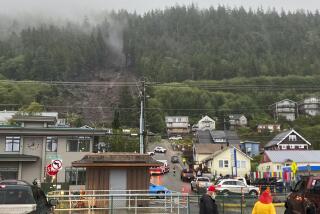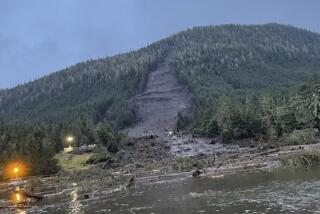It’s tiny Newtok, Alaska, against the tide of warming
- Share via
BETHEL, ALASKA — Stanley Tom recently invited the most politically connected man in the state to visit his small village on Alaska’s western coast.
Tom wanted U.S. Sen. Ted Stevens to witness for himself the continuing natural disaster that threatens Newtok and dozens of other coastal villages.
Tidal erosion caused by warming temperatures continues to eat away at the shoreline and imperil not just the Yupik Eskimo inhabitants but their ancient way of life. In Newtok, population about 320, the chopping waters advanced 80 feet this year alone.
“Time’s running out,” Tom, the village leader, said during a layover in this working town west of Newtok. Tom has been traveling extensively in recent months to try to raise awareness -- and money -- to fund the relocation of his village. Such a move would cost $80 million to $130 million, the government estimates. A small fraction has been pledged.
Native leaders and environmentalists blame bureaucracy and the unwillingness of any government agency to lead the way.
During a Senate hearing in Anchorage in mid-October, Tom made his case to Stevens, who acknowledged the dire situation. But Stevens told Tom that many other villages needed help too.
Tom awaits the senator’s visit. He said he would like to give a personal tour of the village’s disintegrating infrastructure.
Newtok sits on tundra along the Ninglick River at the far edge of the Yukon-Kuskokwim Delta. A collection of about 70 shacks and houses stands atop stilts, connected by a gap-toothed boardwalk that winds through the village. The villagers live much the way they have for the last 2,000 years: hunting and fishing as a way of life.
But the village has modernized, and that is what has been affected most.
The barge landing washed away, making it treacherous to load and unload fuel and other essentials. The landfill, too, was wiped out, forcing villagers to haul garbage to a distant site across the river. And a second river, the Newtok, where portable toilets were emptied for years, now routinely floods and spreads human waste through the community.
Tidal erosion has made the village so vulnerable that the next big storm could destroy what remains, said Deborah L. Williams, who heads Alaska Conservation Solutions. The organization addresses problems related to climate change.
“The situation is very urgent,” said Williams, who visited Newtok this year. She said the permafrost “was melting like chocolate ice cream in the sun.”
Williams, a former Interior Department official under the Clinton administration, said Newtok could be consumed in five to 15 years. That’s assuming a big storm doesn’t hit beforehand. Tom and other tribal leaders fear the erosion could reach the town much sooner, perhaps in as little as three years.
Villagers, with help from state officials, have found a new site, nine miles away on Nelson Island. But moving people, houses and major buildings, such as the school and clinic, will be by all accounts an epic endeavor.
For millenniums, ice shelves and permafrost along the coast acted as shields against storms and tidal forces, but warming temperatures have melted much of those natural barriers.
More than 180 Alaskan villages are in danger, according to government reports. Those regarded as most imperiled include Newtok, Shishmaref and Kivalina. All three villages have made plans to relocate.
“How is it going to work, and who is going to pay for it? That’s the million-dollar question,” said Sally Russell Cox, a state planner involved in the Newtok relocation.
Cox said moving an entire village isn’t too farfetched: “Villages in Alaska have relocated before, and Natives have been doing it on their own for thousands of years.”
The Native people of Western Alaska were traditionally nomadic, following fish and game. Natives began settling in permanent communities only within the last century, and a majority of them in the last 50 years.
“That’s the paradigm we’ll be using: the community actively participating and the government providing assistance,” Cox said. She said “a huge appropriation of government funds” to pay for the relocations would probably not materialize.
At this point, the priority is to buy more time for Newtok and the other villages by holding off the erosion as long as possible, Cox said. This would mean reinforcing sea walls and retrofitting major buildings. Temporary barge landings may be built.
It’s also imperative that the villages develop emergency evacuation plans in case a big storm hits before relocation can begin, Cox said.
The most viable idea for Newtok involves evacuating residents to the new site on Nelson Island. But as of now, no building exists there that could shelter the entire population.
“We don’t have answers yet,” Cox said. “We’re working on them.”
--
More to Read
Sign up for Essential California
The most important California stories and recommendations in your inbox every morning.
You may occasionally receive promotional content from the Los Angeles Times.










